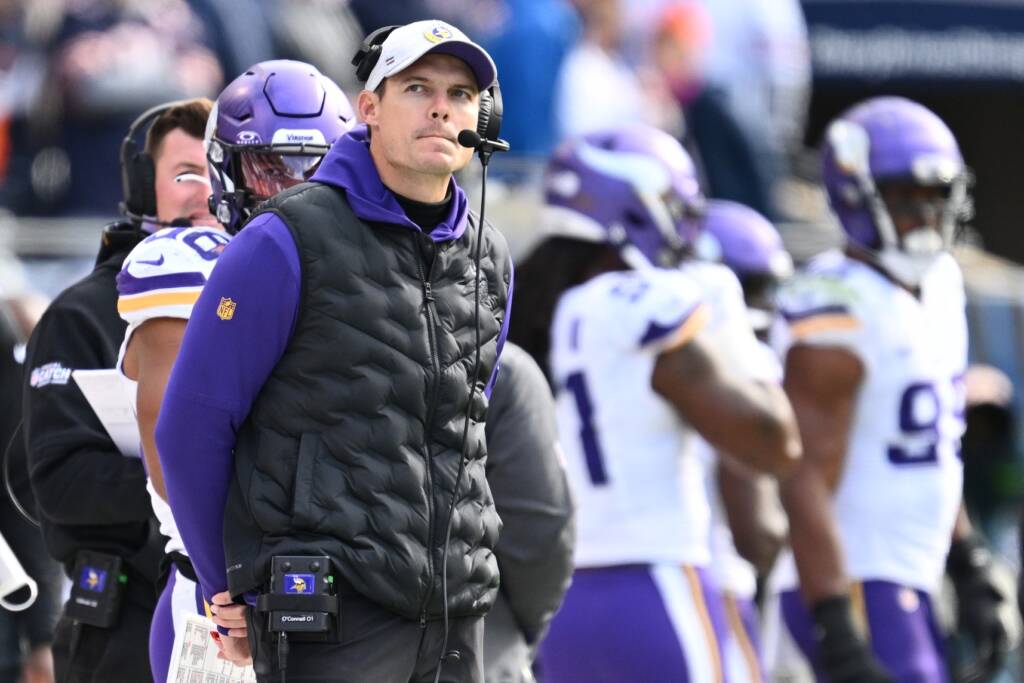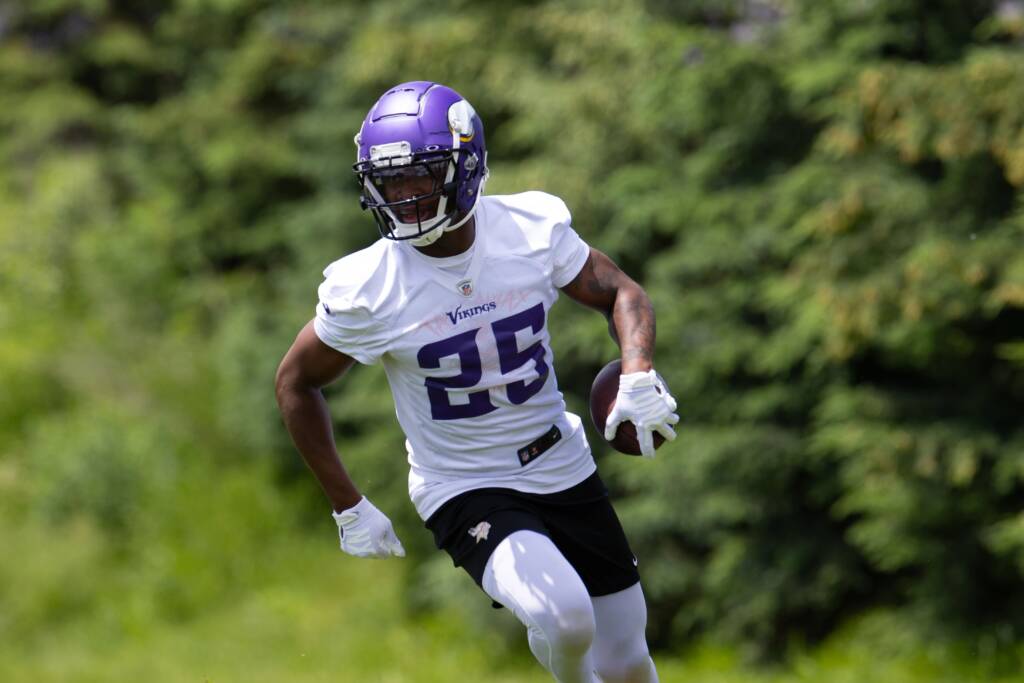The Minnesota Vikings lost a frustrating game to the Chicago Bears on Monday Night Football, falling 12-10 after Cairo Santos‘ game-winning field goal with 10 seconds left. The loss brought the Vikings back to .500 and capped a disappointing two-game stretch where they turned the ball over seven times.
Many small moments add up to a close loss for a team, but the biggest complaint Vikings fans seem to have besides turnovers is conservative decision-making from Kevin O’Connell, the team’s head coach and play caller.
Conservative four-minute drills
In the last three weeks, the Vikings have had the ball with a first down and under five minutes remaining on the clock, a great opportunity to shut the door on their opponent. In each case, they have played very conservatively.
Against the New Orleans Saints, the Vikings went three-and-out three consecutive times to end the game. They ran on eight out of nine opportunities, with the only pass coming on third-and-12. Against the Denver Broncos, they had first-and-10 at the Denver 12-yard line and went run, run, pass to gain no yards and kick a field goal. They got the ball on the fringe of FG range against the Bears with 3:28 left and went run, run, pass to gain no yards and punt.
Given Minnesota’s stellar performance in one-score games last season, you may think this is a new phenomenon from O’Connell this season. It really isn’t, though. In most of the Vikings’ one-score wins last year, they needed a score on their final drive because they were either tied or trailing. For the most part, that meant they couldn’t just try to run the clock out.
There are four games where they had a chance to try to run it out: against the Miami Dolphins, Arizona Cardinals, New England Patriots, and the New York Jets. They were up by two scores in the Miami game, so we can excuse their conservative play. In the Arizona game, they went run, run, pass, then punted. They went run, run, run against New England and New York.
Some teams can run the ball in this situation and get away with it, converting for first downs until time expires. The Vikings have been abysmal when they try this strategy, though. It’s a struggle to gain even one or two yards, and of the eight drives referenced above, only one has resulted in a better situation than third-and-seven. The drives have succeeded in eliminating opponents’ timeouts. However, they have always given the other team a legitimate chance to score, forcing the defense to try to make a stop. That worked in 2022 but has failed the team the last two weeks.
I want to be clear — I think O’Connell has been an excellent play-caller and play-designer for the Vikings throughout his tenure. He helped Kirk Cousins shred the San Francisco 49ers’ defense and did an excellent job working with Josh Dobbs to create offense on the fly in the Atlanta Falcons’ game. This piece isn’t critiquing O’Connell’s creativity or ability to sequence those plays. Instead, it’s about his philosophy of game management in these situations.
That doesn’t mean that O’Connell has to come out guns blazing, trying to throw bombs and score a TD. With a more athletic QB in Josh Dobbs, O’Connell could have used QB run concepts against the Bears to try to gain more yardage than the under-center runs they attempted. Quick-game concepts could get completions in bounds and keep the clock moving. Play action with rollouts and other quick-hitting throws also keep the clock moving. Throwing incurs the risk of an incompletion to give your opponent even more time. However, you’re already giving them more than enough with failed runs. It’s time for a philosophical change here.
Fourth-Down Decision-making
Some of O’Connell’s fourth-down decisions have also come under scrutiny. Two particular plays in the Broncos game spring to mind: punting on fourth-and-seven from Denver’s 47-yard line and punting on fourth-and-one from the Denver 48. In both instances, fourth-down calculators will recommend that teams go for it. Both punts ended up as touchbacks, which means they netted only 27 and 28 yards, respectively.
O’Connell has generally been pretty consistent in terms of how he makes his fourth-down decisions. Per rbsdm.com, he has gone for fourth downs about 37% of the time the calculator suggests he should in both 2022 and 2023. NFL coaches are typically conservative compared to the calculators on fourth-down decisions, and O’Connell ranked in the middle of the pack in 2022:
He has maintained almost that same rate in 2023. However, Minnesota’s ranking has decreased significantly as other teams get more aggressive:
The two plays I mentioned above stick out as situations where the team should have gone for it. However, the Vikings ran a fake punt on fourth-and-four and a QB sneak on fourth-and-one on the same drive against the Broncos. They also attempted two fourth-down conversions past midfield in the loss to the Bears.
Anecdotally, it felt as if the Vikings were going it on fourth down much more often than they did with Kirk Cousins under center. While I couldn’t find much difference in go-for-it rates by the team between weeks 1-8 and 9-12, I found a split based on win probability. The Vikings have been much more aggressive when down in games. They go for it when the calculators say they should over 50% of the time when they have a win probability less than 40%:
However, when you flip that around, the Vikings once again turtle while they are ahead. They are in the bottom quarter of the league in terms of going for it while they have a win probability of 40-100%, only doing so about 25% of the time:
From this, we can see a connection between O’Connell’s conservative playcalling while trying to run the clock out and his conservative decisions on fourth downs while ahead.
challenging decisions
In terms of challenges, O’Connell has had a few interesting choices over the last couple of weeks. In the Broncos and Saints games, he had the opportunity to challenge a couple of spots that he turned down. He lost a challenge against the Saints on an incompletion to Jordan Addison that seemed unlikely to succeed. On the first play against the Bears, he chose not to challenge a very close call that would have put them in FG range:
Management of challenges may be a pain point for some fans, but it’s not something I’m as worried about. Losing a challenge is a big negative. Coaches not only lose a timeout but also eliminate their opportunity to earn a third red flag. Therefore, they have to be sparing with a potential second challenge to avoid losing the opportunity to make one on a more critical play later in the game.
The Saints game offers a good example. O’Connell passed up a challenge on a Josh Dobbs rush that the officials ruled short. Because he had already lost a challenge, he would have been out of challenges early in the third quarter. O’Connell later challenged a play that could have been a critical fumble, a much bigger swing than a third-down conversion. That challenge didn’t go as planned, either. The officials ruled that play complete and down by contact rather than the desired result of a completion and a fumble.
To me, how the NFL administrates challenges is part of a larger structural problem with officiating. The league can overrule certain plays automatically, like turnovers and scoring plays. However, it also strangely gets to pick and choose spots to overturn mistakes. For example, in the Bears game, they called back a long play by Addison after the catch because his knee was down.
Why should that Addison play be subject to review without a challenge but not the one above? What constitutes a mistake so obvious that it merits an instant review? Why doesn’t that include obvious misses like a facemask by the Saints against Danielle Hunter in that game?
The questions I have about challenges are larger than any coach’s decisions on making them. O’Connell is 5 for 10 on challenges in his coaching career, and I can’t be too critical of it.
other positive game management aspects
Kevin O’Connell has generally done a good job managing the game in other areas. It’s noteworthy that the Vikings are fifth in pass rate in the NFL and pass 3% more often than expected.
Game-clock math is another aspect where O’Connell shines. While he’s conservative in trying to run out the clock, he understands the most efficient way to use his timeouts to save time. In multiple instances this year and last, he’s run out the clock on a game by having a fourth-down play thrown out of bounds, avoiding the need to punt.
In the Bears game, O’Connell understood the need to call timeouts to give the team one last desperation chance. Contrast this with the time management at the end of the Patriots-Giants game, where Brian Daboll could have called a timeout on fourth down with about 25 seconds left. Instead, he let the Patriots run the clock down to the point where overtime was guaranteed if they made the kick.
Ultimately, Kevin O’Connell’s ability as a play caller and locker room leader has outweighed his conservative end-of-game tendencies, leading to a 19-10 record as Vikings head coach. He should be commended for being aggressive when down in games. However, the evidence and recent results clearly indicate that O’Connell needs to keep his foot on the gas while the Vikings are up.





